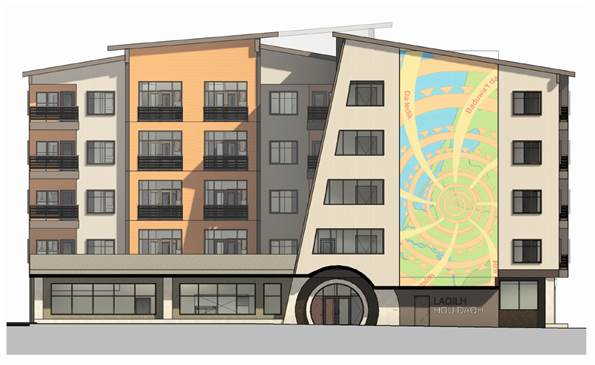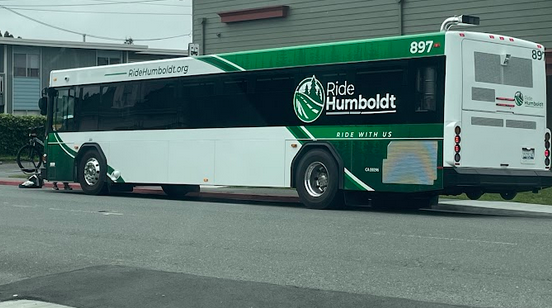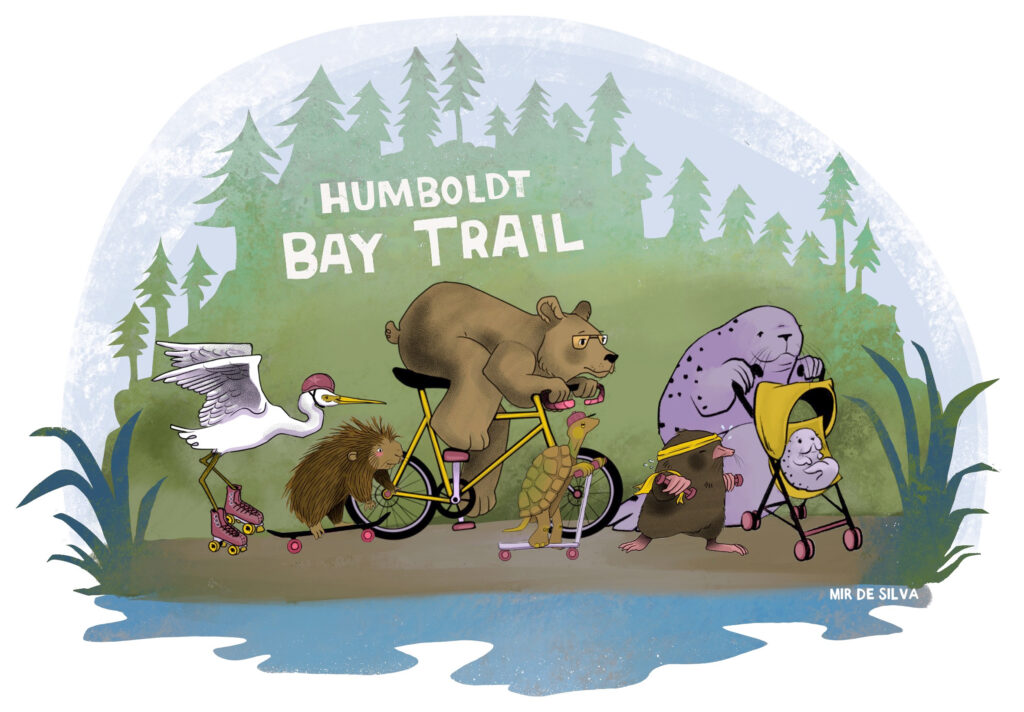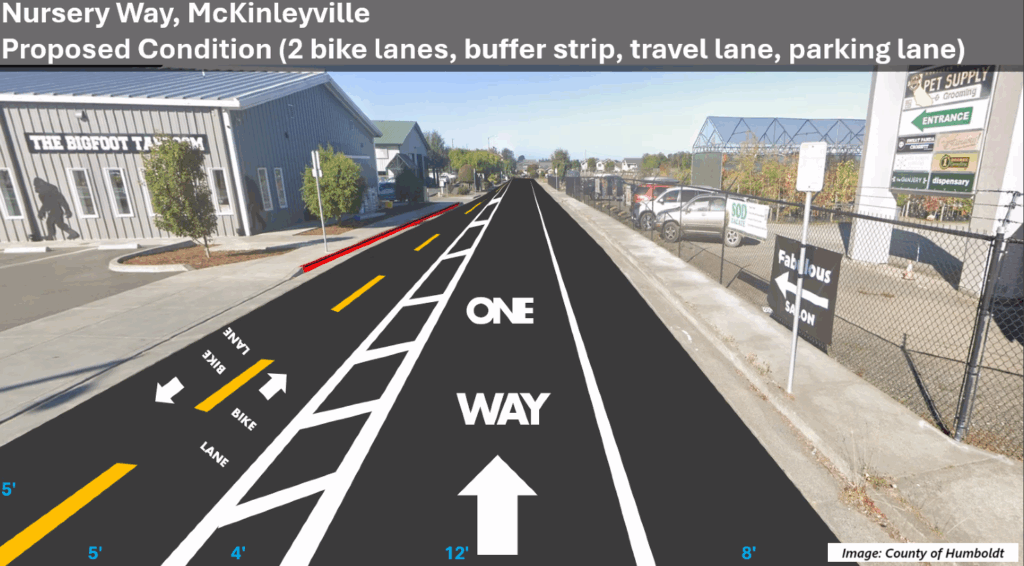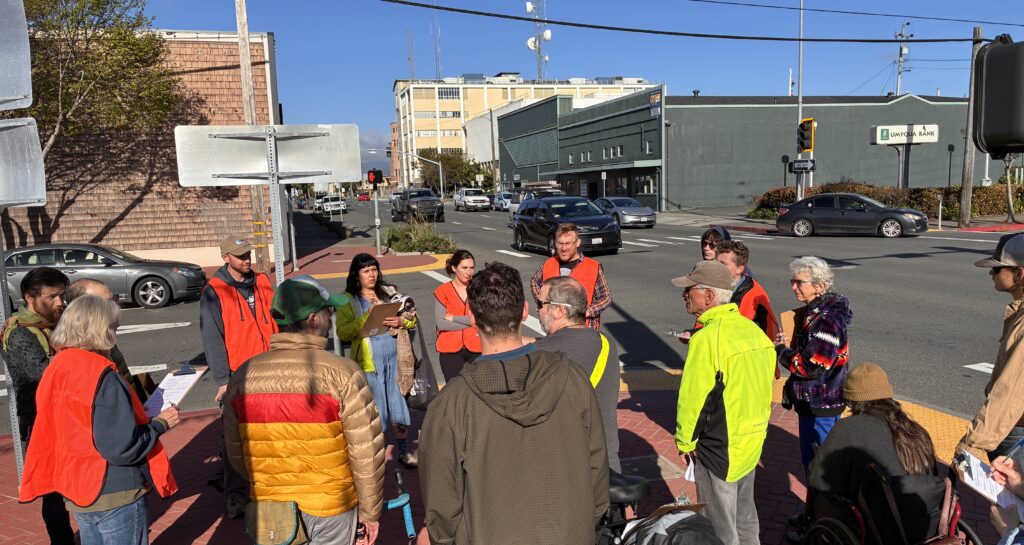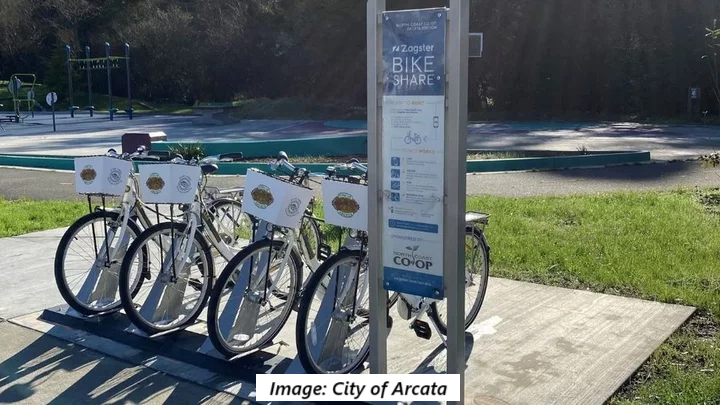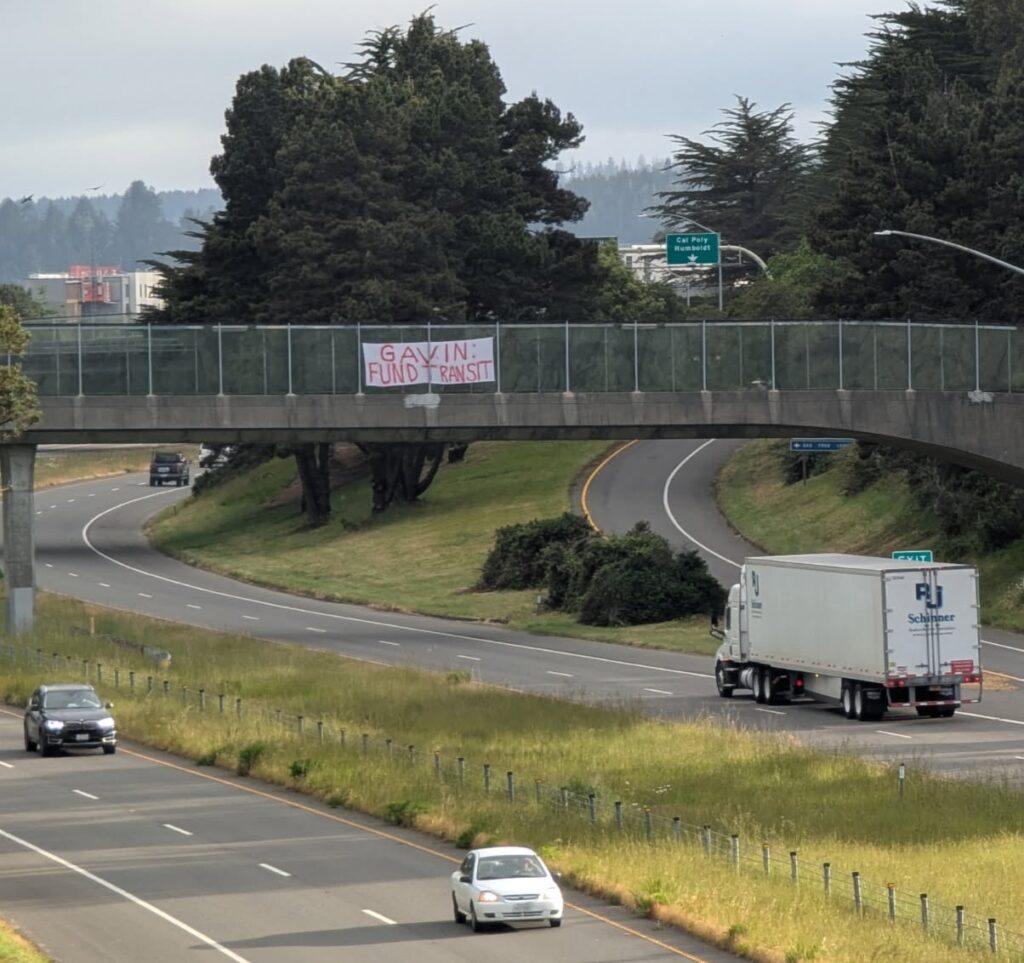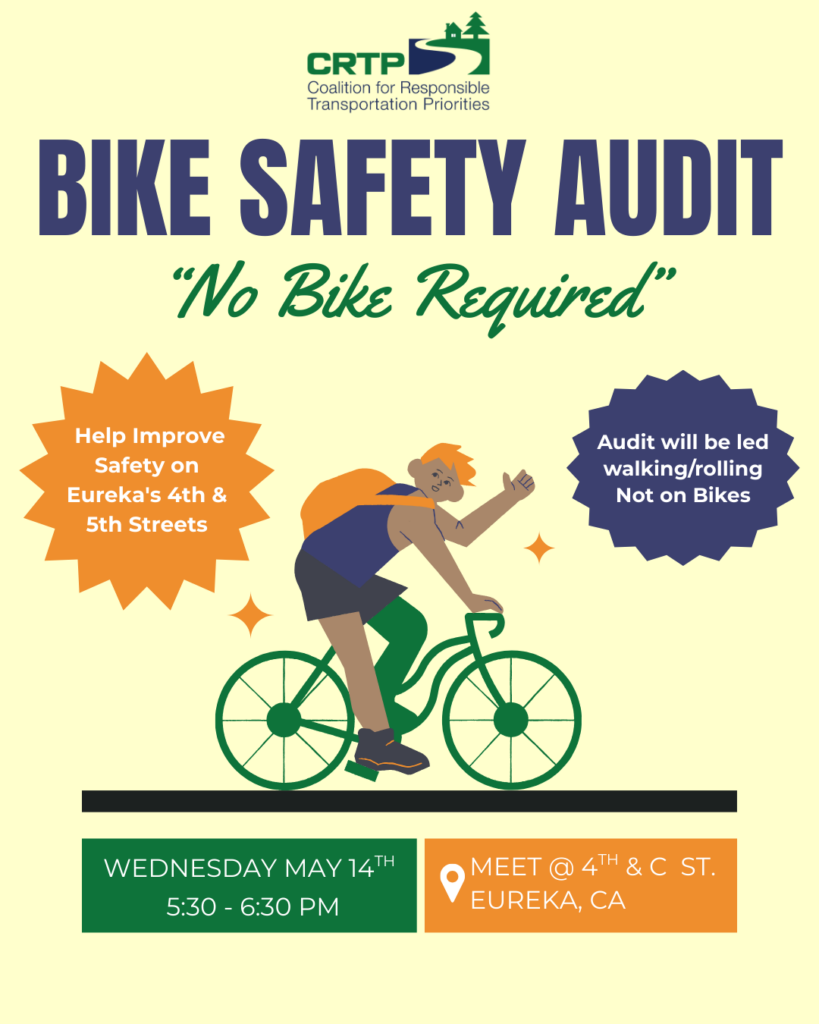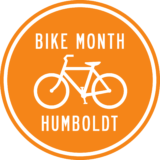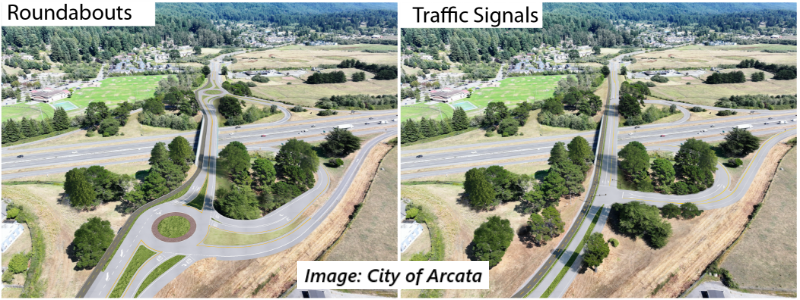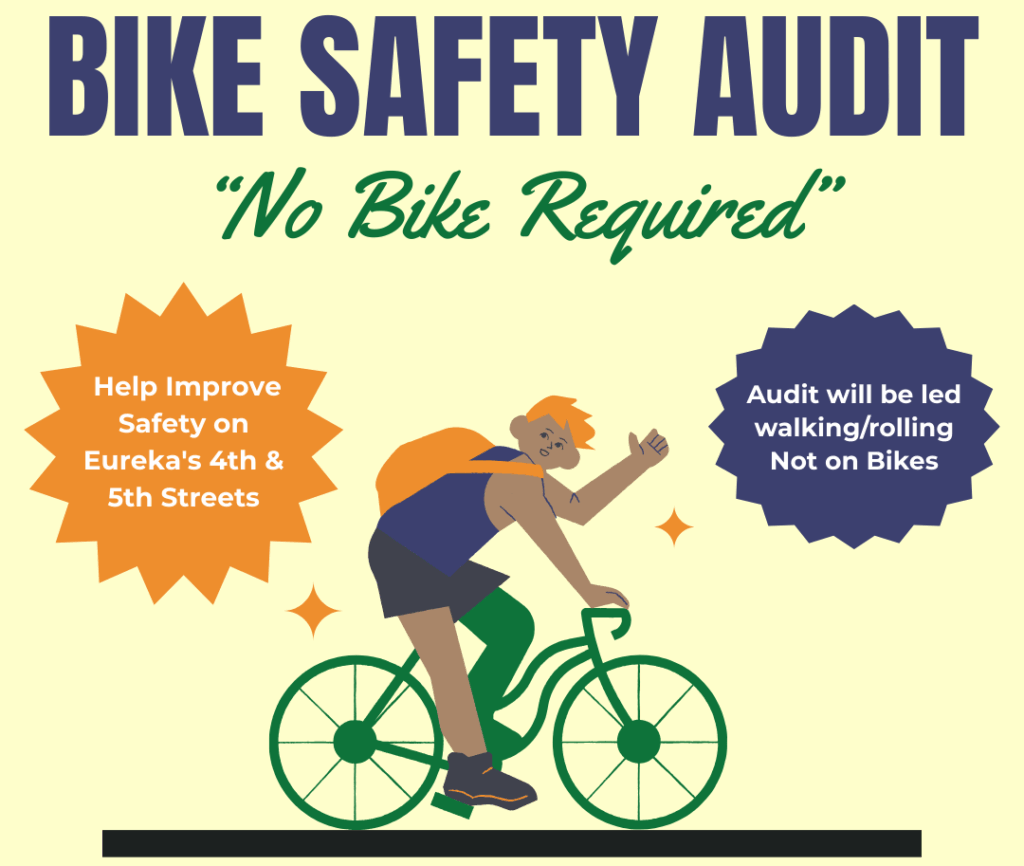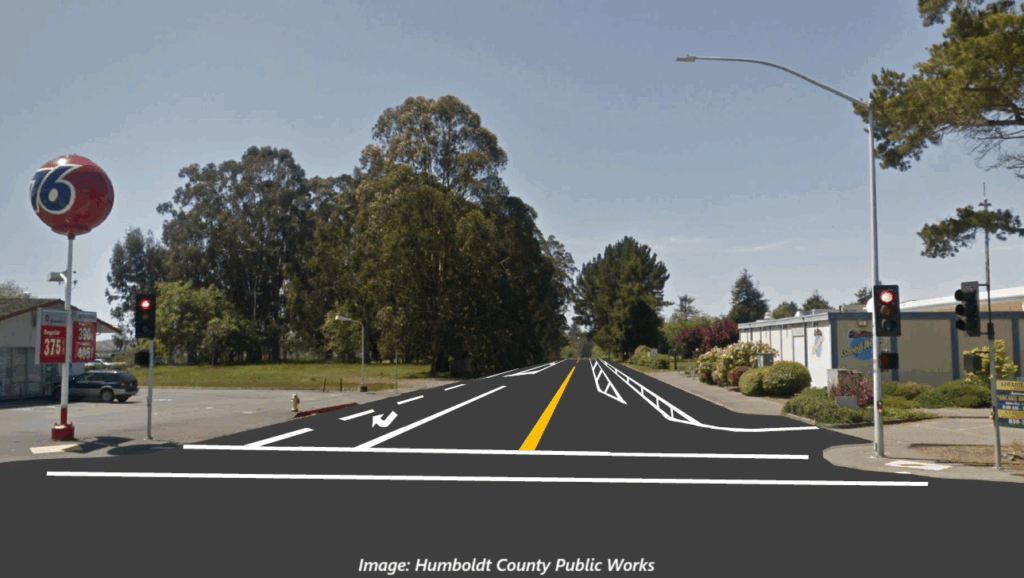The Collector is CRTP’s weekly transportation news roundup, published every Friday. We focus on North Coast news, but we also include relevant state, national and international transportation news – plus other items that we just find kind of interesting! You can submit items for consideration, or just enjoy the news collection!
Where Should New Homes Be Built in Humboldt?
The Collector
July 11, 2025
Where Should New Homes Be Built in Humboldt?
This week, we were happy to see the Wiyot Tribe win $4 million to help build two housing projects in downtown Eureka, one primarily for elders and the other focused on families. These projects will replace underutilized city parking lots with 93 affordable housing units, all within walking and biking distance to many jobs and services, and served by multiple transit systems. This is what’s called “infill,” and it’s the kind of housing we need in order to reduce climate pollution, improve health and safety, and make living in our region more affordable.
But it’s not inevitable that future homes will be built in infill locations. Over the last century, most local homes were built on former agricultural and wild lands in sprawling, car-dependent locations, and there is a lot of pressure to continue that kind of development. It takes years of effort by tribes, public officials, planners, and advocates to make projects like the Wiyot Tribe’s possible, and they regularly face fierce backlash. (Remember the millions Rob Arkley pumped into his ballot initiative last year trying to block this and other downtown housing?)
A lot of the decisions about where to build housing start with an obscure state-mandated process called the Regional Housing Needs Allocation (RHNA). Every eight years, the state assigns each region a specific number of new housing units in every income category, and requires local governments to make plans to ensure those homes are actually built. However, the region makes its own choices about how to divide the responsibility for those new homes among local jurisdictions. In Humboldt, a lot about the future of housing and transportation hinges on whether most of the homes will be built in existing job and service centers like Eureka and Arcata, or will be assigned instead to the mostly low-density unincorporated county.
At a meeting next week, the Humboldt County Association of Governments will hear its first update on the local RHNA allocation for the next eight-year cycle, and provide input on how the new housing should be divided among local governments. CRTP is watching closely. As always, we will be advocating for local, regional, and state policies that support infill housing development and discourage sprawl.
“When Driving Is Not an Option”
National advocate and author Anna Zivarts is coming to Humboldt in two weeks to give a free public talk! Zivarts is the founder of the Week Without Driving and author of When Driving Is Not an Option. The talk will be on Thursday, July 17th, at 7 pm at Arcata’s D Street Neighborhood Center. Topics will include the nondrivers in every community, the importance of meeting the transportation needs of nondrivers, how communities can work better for nondrivers (and everyone else), and valuing the expertise of nondrivers. See you next week!
Eureka’s C Street Bike Boulevard Starts Construction Next Week!
The long-planned transformation of C Street into a bike-friendly thoroughfare is about to begin. The project extends from Henderson Street to Waterfront Drive. It includes traffic-calming curb extensions, median islands, and flashing beacons at key intersections, and other measures to reduce traffic speeds. Crucially, it also includes measures to reduce the volume of traffic: although vehicles will still have access to every block, alternating one-way designations will prevent drivers from using the street as a cut-through, while continuing to allow two-way bike travel throughout. Unfortunately, the crossings of 4th and 5th Streets are left out of the project (Caltrans is supposed to make improvements there), and improvements in Old Town don’t amount to much more than painted “sharrows.” But overall, the C Street Bike Boulevard will be a nice addition to the city’s growing low-stress bicycle network.
Another Bear Is Killed By a Driver
While CRTP primarily focuses on transportation safety for people, we care about our non-human neighbors, too. So periodically we feel obliged to remind the community that “roadkill” is a major hazard for wildlife in our region (and throughout the world), and can even drive some populations to extinction. Fortunately, we know a lot about how to design roads and highways to reduce or eliminate the problem for many species. The most effective way to reduce the death toll for animals is the same as it is for humans: drivers just need to slow down.
News from Beyond the North Coast
Countries Are Failing the Climate, But Cities Are Stepping Up
A new report shows that, while countries across the globe are failing to take the needed steps to reduce climate pollution, cities are increasingly stepping into the void with their own ambitious plans and actions. In this country, Congress and Trump administration are currently eliminating clean energy and transportation programs, clawing back grants to fund bike, pedestrian, transit, and zero-emission vehicle infrastructure, and urging Americans to “gas up” and drive more. The Trump administration is even slow-walking safety funding. And we can’t rely on the state to save us, either, as the supposedly forward-thinking California government continues to pump millions into doomed highway expansions and cut bike and pedestrian funding. In this context, the importance of local climate action is more clear than ever. While we are devastated by many of the actions being taken at federal and state levels, CRTP is glad to work with many local partners and allies on the North Coast trying to tackle our own climate-harming emissions.
Cameras Confirm: Lots of Drivers Are Speeding
Inexplicably, it has long been illegal to enforce speed limits with cameras in California. However, a 2023 law created a pilot program to allow speed cameras in a few cities, and the first data are starting to come in. Unsurprisingly, the results show that a lot of drivers regularly exceed the speed limit – and not just by a little. Research shows that automated speed camera enforcement can significantly reduce speeding, and if the cameras are placed and monitored in a fair and equitable way, can avoid many of the inequities inherent to human traffic enforcement.
Parents Arrested After Driver Kills Their Child
When a 7-year-old kid was killed while trying to cross the street in Gastonia, North Carolina, police did not charge the driver – or the engineers and planners who designed the street – with any crime. Instead, they arrested both parents for allowing their children to walk home by themselves.
The Collector is CRTP’s weekly transportation news roundup, published every Friday. We focus on North Coast news, but we also include relevant state, national and international transportation news – plus other items that we just find kind of interesting! To submit items for consideration, email colin@transportationpriorities.org.
Free Buses Throughout Humboldt This Month!
The Collector
July 4, 2025
Free Buses Throughout Humboldt This Month!
The Humboldt Transit Authority was founded in 1975. To celebrate their fiftieth birthday, they’re offering free rides on all buses throughout the month of July! Regular bus riders will save a little money, and it’s also a great opportunity for new riders and the bus-curious to get out there and try public transit. Unfortunately, however, you can’t ride today – there are no buses running on Independence Day.
“When Driving Is Not an Option”
National advocate and author Anna Zivarts is coming to Humboldt in two weeks to give a free public talk! Zivarts is the founder of the Week Without Driving and author of When Driving Is Not an Option. The talk will be on Thursday, July 17th, at 7 pm at Arcata’s D Street Neighborhood Center. Topics will include the nondrivers in every community, the importance of meeting the transportation needs of nondrivers, how communities can work better for nondrivers (and everyone else), and valuing the expertise of nondrivers. Don’t forget to mark your calendar!
Funding Awarded for Loleta Transportation Safety & Last Chance Grade Designs
The Humboldt County Association of Governments will be leading a new planning effort to improve safety for kids walking and biking to school in Loleta, as well as connectivity to tribal lands. The plan is funded by a $310,000 grant from Caltrans. We appreciate this funding and look forward to safer conditions in Loleta. However, we are also struck by the contrast with another funding announcement this week: $40 million from the state to “jump-start the design phase” of the Last Chance Grade project.
CRTP has always supported a long-term, responsible solution for the long-running problems on US-101 at Last Chance Grade, and we know the project will be expensive. But it is hard not to notice that the state spends hundreds of times more to maintain highways than it does to ensure kids can get to school safely. Because while the Last Chance Grade project is unusually expensive, Caltrans routinely spends tens of millions of dollars to repave sections of rural highway in our region, while local governments and tribes – and even staff within Caltrans itself – are forced to compete with each other for much, much smaller amounts of money dedicated to safety and sustainability.
Caltrans Wants Feedback on Eureka Slough Bridges Project
Caltrans plans to replace the US-101 Eureka Slough bridges starting in 2029, and the draft environmental document for the project is now available for public review. CRTP is happy to see that both design options include separated bike and pedestrian pathways in both directions. You can find more information, including the Environmental Impact Report and how to comment on it, here.
“Walkies Only”
At CRTP, when we talk about “pedestrians,” we mean people walking as well as people using wheelchairs, scooters, canes, and other mobility devices. That’s why you might notice us using phrases like “walking and rolling” when we talk about what pedestrians do. It’s also why we highly recommend that our supporters read an ongoing series of opinion pieces in the North Coast Journal about Cal Poly Humboldt’s lack of accessibility for people with mobility limitations. It’s is an important reminder of the need to design streets, roads, sidewalks, buildings, and other public places in ways that work for people of all ages and abilities.
News from Beyond the North Coast
Big Changes for Transportation and Housing
The state budget bill just signed by Governor Newsom includes a bunch of policy changes aimed at encouraging more housing production, including exempting most new infill housing projects from environmental review. At the same time, new climate rules also took effect this week which are expected to moderately increase the price of gasoline over the next several years.
Both the new housing laws and the new climate rules include a host of highly technical details, and for transportation advocates there is plenty to both like and dislike. We hope that, as proponents have argued, the result will be more walkable, transit-oriented development and less climate-destroying transportation pollution. But we also know that at least some of the changes to the climate rules are likely to increase emissions, and that lengthy environmental reviews are not the only barrier to infill housing.
Why Aren’t Kids Biking These Days?
American children are biking a lot less than their parents and grandparents did. It may be partly because parents are increasingly aware of the prevalence of dangerous streets and dangerous vehicles. But relinquishing this form of independent mobility comes with significant costs to kids – and their parents.
Autonomous Cars Are Driving More Like Humans
Proponents of self-driving vehicles have long claimed that they are so much safer than human drivers that traffic deaths will soon become a thing of the past. But at least one major autonomous vehicle maker admits that they are now training the cars to act more like human drivers, because passengers and other drivers get impatient with slow, risk-averse robot driving. If this trend continues while autonomous vehicle adoption increases in future years, the consequences for street safety could be enormous.
The Collector is CRTP’s weekly transportation news roundup, published every Friday. We focus on North Coast news, but we also include relevant state, national and international transportation news – plus other items that we just find kind of interesting! To submit items for consideration, email colin@transportationpriorities.org.
Humboldt Bay Trail Grand Opening Celebration Tomorrow!
The Collector
June 27, 2025
Humboldt Bay Trail Grand Opening Celebration Tomorrow!
The bike and pedestrian trail along the shores of Humboldt Bay between Eureka and Arcata is complete! The new trail fills a major gap in the Humboldt Bay Trail and functions as a key part of the bigger Great Redwood Trail. We’ve been waiting a long time for this, and it’s time to celebrate!
Trail-related events Saturday morning include volunteer clean-ups, a do-it-yourself fun run, a group skate date, and more. Then, at 1 pm, you can join CRTP and Latino Outdoors for a group bike ride from the Arcata Marsh down to the Adorni Center, where the official celebration will just be getting started. From 3-6 pm at the Adorni Center, we’ll have live music and a DJ, food trucks and beer, bike rentals and tune-ups, bike valet service, and lots of local nonprofits and agencies providing information and giveaways.
The celebration will start with some mixing, mingling, and music, followed by brief comments from local leaders and trail supporters including State Senator Mike McGuire, Great Redwood Trail Agency Executive Director Elaine Hogan, and Humboldt County Public Works Deputy Director Hank Seemann. After that, it’s just a party!
The Humboldt Transit Authority will be running a bus back and forth from 11 am to 7 pm for people who only want to walk/run/bike/skate one way, and it will be coordinated with a vehicle from Wildtrail Tours for added bike hauling capacity. You can find all the details on the event website. See you tomorrow!
Want to Take Your Support for CRTP to the Next Level?
CRTP is looking for new members for our Board of Directors. Candidates for the Board should share a commitment to our mission and goals, and should have time or other resources to contribute to the organization. To find out more about joining CRTP’s Board of Directors, or to submit a completed application, email colin@transportationpriorities.org.
If you’re not quite ready to join the Board, here’s another opportunity to consider: We are currently seeking transit riders to lead ride-alongs with local decision-makers during this year’s Week Without Driving. If you ride the bus regularly and would be interested in sharing your transit experience with a local leader or public official, email kelsey@transportationpriorities.org.
Victory: Transit Funding Restored to State Budget
Thanks to pressure from transit supporters across the state, the budget deal recently announced by Governor Newsom and the state legislature restores transit funding that the governor previously proposed cutting, and includes some emergency support for the big transit systems in Los Angeles and the San Francisco Bay Area. This represents a major win for transit, and it wouldn’t have happened without the thousands of phone calls and emails from people like you. Meanwhile, the fate of major transit grants currently funded from the state’s cap-and-trade program (including millions of dollars in local grants on the North Coast) remains unresolved, although state leaders have promised to address the issue soon.
McKinleyville Commitee Reaffirms Support for Town Center Plans
There was a packed house Wednesday for the McKinleyville Municipal Advisory Committee meeting, full of supporters of the Town Center plans (including CRTP members!) as well as opponents. County planning staff and Supervisor Steve Madrone spent a long time seeking to educate people about the plans – which have been developed with extensive public input over the last five years – and dispel misinformation that has been spread recently by some opponents.
The committee reaffirmed its support for the Town Center plans, which call for a more walkable, bikeable, transit-friendly core to the community. However, the issue is expected to be back on their agenda again in July, including a specific question about whether they really want to replace two of the current lanes on Central Avenue with protected bikeways. CRTP and our supporters fought hard for this redesign for many years, and we will be working to make sure the committee and the county don’t go back on their promise of a safer Central Avenue.
Earlier in the meeting, the committee weighed in on two other street redesigns. First, they approved final plans for the Hiller Avenue quick-build project. While CRTP is disappointed that the committee chose a design for the intersection of Hiller & McKinleyville Avenue that we don’t think will provide adequate protection for bicyclists and pedestrians, we are excited for the rest of the project, which includes protected bikeways, traffic calming, and public art.
Next, the committee discussed a proposal to make Nursery Avenue into a single-lane, one-way street with a two-way bike facility, in an attempt to address current issues on the street including drivers regularly parking in the bike lanes. At CRTP’s encouragement, the committee asked the county to include physical separation elements between the driving lane and the two-way bikeway to keep cars from parking there, too.
News from Beyond the North Coast
Economist: Too Much Driving (& Parking) Is Bad for Business
Economic development officials often argue that roads and highways stimulate local economies, and business owners routinely fight for more parking for their customers. But a new economic analysis shows that, at both city and neighborhood scales, more driving and more parking are both correlated with lower economic productivity. It turns out that driving is expensive, and there are usually more productive uses for land than highways or parking lots.
On the other hand, if the economic analysis doesn’t convince you, and you want to know how to design a community with too much parking, there’s now a video game just for you!
Drivers Who Kill With Their Cars Often Keep on Driving
Following up on its recent investigation that revealed just how often our legal system allows dangerous drivers to stay on the road, CalMatters has a new story about how, even on the rare occasions when the law requires a driver’s license to be revoked or suspended, courts often fail to report that fact to the DMV.
The Collector is CRTP’s weekly transportation news roundup, published every Friday. We focus on North Coast news, but we also include relevant state, national and international transportation news – plus other items that we just find kind of interesting! To submit items for consideration, email colin@transportationpriorities.org.
CRTP Publishes Bike Safety Audit Report
The Collector
June 20, 2025
CRTP Publishes Bike Safety Audit Report
Following up on last month’s bike safety audit in Eureka’s 4th and 5th Street corridor, CRTP has published a report of findings that documents the issues identified by audit participants and suggestions to make the corridor safer for biking. We already knew that 4th & 5th Streets were dangerous for biking, but the audit report identifies specific problems and specific solutions.
Perhaps the biggest idea to come out of the bike safety audit is to turn one lane on 4th Street and one lane on 5th Street into protected bike lanes. This single design change could address a lot of the safety issues by providing a safe place to ride on the street, reducing the distance to cross the street, lowering traffic speeds, and mitigating the unpredictable driver behavior that comes from having three general vehicle lanes going in the same direction.
Take the Vision Zero Survey
As we mentioned last week, the Humboldt County Association of Governments is developing a Vision Zero Action Plan for the county, and they want to hear from you. Click here to take their survey about transportation safety. And don’t forget to keep making reports on Street Story about crashes, near-misses, and hazardous locations as well. CRTP is making sure that Street Story reports are considered as the plan is developed.
Trails! Trails! Trails!
The Humboldt Bay Trail Grand Opening Celebration is coming up in just over a week, and people are definitely getting excited.
In other good trail news, at its meeting next week the California Transportation Commission is slated to allocate construction funding for Arcata’s Annie & Mary Trail Connectivity Project (a new trail from the Sunset Avenue skate park all the way past Valley West to the first pump station on Baduwa’t), as well as a new financial contribution toward the project from Caltrans. The regional commuter trail network is growing before our eyes!
Bike to the Juneteenth Day Festival!
Black Humboldt’s 7th annual Juneteenth Day Festival is taking place this Saturday at Halvorsen Park in Eureka. CRTP is providing bike valet, so we can watch your bike while you enjoy the festival. See you on Saturday!
Affordable Housing and Parking in Arcata
Some current residents of Arcata’s Bayside neighborhood have been speaking out recently against the “Roger’s Garage” affordable housing project, which proposes to build 53 new affordable housing units on Old Arcata Road. Some of the complaints have to do with the fact that the site’s soil is contaminated from its former use as a mechanic shop, although the site has been contaminated for many years and the housing project would be required to clean it up. But a lot of the complaints, as usual, are about parking.
Here are a few things to remember about parking and housing development: First, there is a direct tradeoff between parking and housing. The more parking is provided, the less housing can be built, and the more expensive that housing is. Second, many people make car ownership and driving decisions based in part on residential parking availability, so a housing development with less parking will almost certainly result in residents with fewer cars. Third, if there is ever a real parking “shortage,” there are effective management tools to address that situation, like a residential parking permit system.
The Roger’s Garage project is not exactly in a walkable location, but it will be quite bikeable once Caltrans completes safety improvements to the US-101 interchange. Given the dire need for more affordable housing in our region, CRTP supports this project, and encourages the city to coordinate with other agencies on bike, pedestrian and transit improvements to better serve the neighborhood as it develops.
News from Beyond the North Coast
California Transportation Commission Looks to Fund More Highway Expansions
The commission is notoriously pro-highway and autocentric, and rarely objects to big projects proposed by Caltrans. Advocates are increasingly frustrated as enormous sums of money flow toward highway expansions that undermine the state’s climate and safety goals, and have called out a number of boondoggles in advance of next week’s meeting – including a multimillion dollar project to add lanes to a state highway that could be under water in less than ten years due to sea level rise.
Tellingly, the Trump administration hasn’t uttered a peep about this kind of “waste, fraud and abuse,” despite making the state’s biggest mass transit project into a culture war topic and focus of the president’s feud with Governor Newsom.
If Every City Were Like Copenhagen, We’d All Be a Lot Healthier
A new study quantifies some of the benefits of biking at a societal scale. One striking finding: if cities around the world all got up to the levels of biking currently found in the Danish capital, it would reduce global auto emissions by 6% and save nearly half a trillion dollars in health care costs every year.
The Collector is CRTP’s weekly transportation news roundup, published every Friday. We focus on North Coast news, but we also include relevant state, national and international transportation news – plus other items that we just find kind of interesting! To submit items for consideration, email colin@transportationpriorities.org.
This Is Not Normal
The Collector
June 13, 2025
This Is Not Normal
At CRTP, we continue to do the important work of educating and advocating for safe, sustainable and equitable transportation on the North Coast. We keep sending out newsletters and emails and social media posts about local issues and events, and it might seem like everything is normal. But it isn’t.
In the long term, we can’t keeping doing this work without the rights and protections afforded to us by a democratic society, which appear to be increasingly under threat from a federal administration with authoritarian tendencies. We also can’t do this work if there’s no more objective research on how to improve safety, equity and sustainability, and if our communities and institutions are targeted by the federal government because they use words like “climate change” and “equity.” And our work to improve transportation doesn’t matter much if the members of our community are afraid to leave their homes.
We are a small organization focused on local and regional issues, but we can’t afford to pretend that the federal government’s actions don’t affect us. We must speak up for freedom of expression, for democracy, for equity, for safety. We support the right of everybody – including immigrants, LGBTQIA+ people, and other marginalized communities currently under attack – to use streets, bike lanes, sidewalks, public transit, and other public spaces without fear, to get where they need to go, to express themselves, and to participate as full members of society. We stand in solidarity with all members of our community.
Regional Vision Zero Planning Effort Kicks Off Next Week
Vision Zero is both an acknowledgement that traffic deaths and serious injuries are preventable, and a commitment to eliminate them in a specified time period. Some local Humboldt County governments have officially adopted Vision Zero policies, but most have not. Next week, however, the Humboldt County Association of Governments officially kicks off development of a Vision Zero Action Plan for the whole county with a public open house on Tuesday evening from 5:30 – 7:30 pm at Eureka’s Wharfinger Building. Drop in to learn more about the plan and provide your input.
Major Progress on Long-Time Priority Projects
Final construction on the Humboldt Bay Trail is very nearly complete, after decades of work from local nonprofits, advocates and agencies. In fact, we are just two weeks away from the official Grand Opening Celebration! Don’t forget to mark your calendars for June 28th.
Crews also recently broke ground on the long-awaited Linc Housing development of 90 new affordable, walkable housing units on three underused city-owned parking lots in Eureka, along with a long list of nearby bike, pedestrian, and transit improvements. Meanwhile, Arcata continues to build up its bike share system (and encourage Eureka to add some stations, too), and the Humboldt Transit Authority just marked a major milestone in its efforts to transition to zero-emission buses.
With many of our most important priorities – including climate action, safe bike and pedestrian infrastructure, walkable communities, and equity for all – under attack from the federal government, it’s an especially important time to acknowledge and celebrate our victories.
A Chance to Restore Critical Transit Funding in the State Budget
The California legislature’s latest budget proposal restores over $1 billion in transit funding that had been cut from Governor Newsom’s last proposal. This is nowhere near the amount of sustained funding needed for transit systems across the state, but it should prevent the kinds of drastic service cuts that might otherwise have been necessary. Click here to urge the governor to accept the transit funding proposal.
In related news, this week the Humboldt County Association of Governments’ Social Services Transportation Advisory Council heard the plan for how new Measure O revenues will be used to support transit over the next year. The proposal includes paying for more late-night Redwood Transit System service, supporting the new long-distance North State Express routes to Willits and Willow Creek, maintaining Eureka and Southern Humboldt Intercity service, and purchasing new vehicles to allow more frequent service. Measure O has already become a critical source of support for local transit, and it wouldn’t have happened without the sustained efforts of CRTP and our allies. Thank you!
News from Beyond the North Coast
State Bike and Pedestrian Funding Will Remain Extremely Low
While legislators restored some transit funding for the next fiscal year, they did not restore the draconian but supposedly “one-time” cuts to the Active Transportation Program from last year’s budget. That will leave the state able to fund only a handful of bike and pedestrian infrastructure projects in the next year, directly affecting the prospects of many local projects on the North Coast.
Other transportation reform legislation seems to be faring a little bit better in Sacramento this year, with bills to allow lower speed limits and quick-build safety projects on state highways, allow installation of speed limiting technology in the cars of dangerous drivers, and streamline sustainable transportation projects all progressing. Check out CalBike’s summary of legislation at the mid-point of the legislative session.
Your Chance to Weigh In on Good Bike Designs
A new study shows that building protected, safe, low-stress bike facilities results in a lot more people riding bikes. But details matter! Caltrans is currently updating its design policies for “Class IV” (protected) bikeways, and CalBike is offering an opportunity for you to provide your feedback directly. CRTP will also be providing feedback to Caltrans through our seat on the California Walk & Bike Technical Advisory Committee.
Time to Get Rid of the Highway Trust Fund?
The Highway Trust Fund would have run out of money long ago if not for continuous bailouts by Congress. Meanwhile, it has continued to pump money into destructive new highway projects while failing to deliver safety improvements, climate action, or congestion relief – or even a well-maintained highway system. Maybe it’s time we try something else.
The Collector is CRTP’s weekly transportation news roundup, published every Friday. We focus on North Coast news, but we also include relevant state, national and international transportation news – plus other items that we just find kind of interesting! To submit items for consideration, email colin@transportationpriorities.org.
CRTP Launches New Tool for Faster Safety Upgrades
The Collector
May 23, 2025
Editor’s Note: The Collector will be taking a break for the next couple of weeks. We’ll be back with more transportation information and analysis in June!
CRTP Launches New Tool for Faster Safety Upgrades
This week, CRTP published our new web-based Quick-Build Toolkit. Quick-build projects use paint and other low-cost materials to improve streets quickly, typically without expensive groundbreaking or paving work. Quick-builds can take months to go from concept to construction, instead of the years or decades that are often required for conventional street improvements.
The new toolkit is meant to support the implementation of urgently needed safe and sustainable transportation upgrades in North Coast communities. Check it out, and then encourage your local government to try out the quick-build approach!
While you’re at it, you can also support a state bill to create a pilot quick-build program for Caltrans, too. With thousands of people dying on state highways every year – including Caltrans’ own employees – there is a clear need for rapid safety improvements on state as well as local routes.
Don’t Let the State Undermine Our Transit Funding Victory
California Streetsblog, a statewide publication about all things transportation, just described the Humboldt County Measure O transit funding win as “one of the largest victories for transportation reform in the state in 2025.” But the promise of this new funding could be undermined immediately if state support for transit is slashed at the same time. Let’s not let that happen.
Email Senator McGuire and Assemblymember Rogers and ask them to preserve existing transit funding programs and include new emergency transit funding in this year’s budget.
Meanwhile, even as the governor proposes no funding for major transit grant programs and drastic underfunding for bike and pedestrian safety, millions continue to roll in for state highways.
One More Week of Bike Month!
The world-famous, pedal-powered Kinetic Grand Championship takes place this weekend, and Bike Month wraps up with the annual Bike Celebration next Saturday, May 31st, at the Jefferson Community Center in Eureka. And while you’re marking your calendar, don’t forget about the Humboldt Bay Trail Grand Opening Celebration taking place in June!
Seeking Bike Valet Volunteers!
CRTP is looking for volunteers to help out with bike valet at the Juneteenth Day Festival on Saturday, June 21st at Halvorsen Park in Eureka. If you’re available to help that day, please reply to this email and let us know. If you want to help with bike valet but aren’t available for the Juneteenth event, let us know that too – we have plenty of other bike valet volunteer opportunities coming up!
Humboldt Parking Lots Host Fish-Killing Tire Toxin
In recent years, scientists have identified a chemical contained in car and truck tires that is highly toxic to aquatic life, particularly coho salmon. With every vehicle emitting trillions of microscopic tire particles on every trip, chemicals like this inevitably end up in the environment. Now, a study by Humboldt Waterkeeper has identified high concentrations of the toxic “6PPD-quinone” in runoff from large parking lots in Arcata and Eureka. So you can add saving the coho to the long list of reasons that we need to start driving less.
News from Beyond the North Coast
Study: Kids’ Risk of Death Almost Doubles When Hit by SUV
A new study has found that the risk of a pedestrian or bicyclist being killed is 44% higher when hit by an SUV or pick-up truck than when hit by a sedan. For kids, the increased risk is 82%. This research adds to the growing evidence suggesting that car and truck bloat is one of the main causes of increasing pedestrian deaths in the United States.
Maybe “Toxic Masculinity” Is More Than a Metaphor
A study in France has concluded that men emit 26% more climate pollution than women on average. Most of that difference is caused by men eating more meat and driving more, suggesting that cultural norms encouraging environmentally destructive male behavior are playing a major role in exacerbating global climate chaos.
Washington Becomes First State to Permit Shared Streets
Shared streets, also called woonerfs, are common in Europe and becoming more popular in the United States. A new law in Washington state is the first in the US to allow speed limits as low as 10 mph and to formalize a hierarchy for shared streets, where bicyclists are required to yield to pedestrians and motorists are required to yield to bicyclists.
Congress Votes to Block California’s Electric Vehicle Mandate
Despite lawyers and Congress’ own parliamentary experts warning that the action is illegal, the US House and Senate have voted to repeal federal approval for California’s plan to transition to 100% zero-emission vehicle sales by 2035. While electric vehicles leave many car-related problems unsolved (see for example the article above about tire pollution), they are nevertheless a crucial part of any serious effort to address the climate crisis. California officials have announced they will challenge the action in court.
The Collector is CRTP’s weekly transportation news roundup, published every Friday. We focus on North Coast news, but we also include relevant state, national and international transportation news – plus other items that we just find kind of interesting! To submit items for consideration, email colin@transportationpriorities.org.
The Fight for Transit Funding Continues
The Collector
May 16, 2025
Two More Weeks of Bike Month!
Thanks to everyone who joined us on Wednesday for CRTP’s bike safety audit on Eureka’s 4th & 5th Streets. We had a great turnout and heard from a lot of people who bike – and people who would like to bike more – about the hazards that currently exist and what might be done to address them. And don’t forget, if you missed the bike audit, you can always make reports about your experiences on Street Story!
Don’t miss out on other great Bike Month events coming up, including a Eureka Mural Ride on Saturday at 11 am. Click here for more information about other bike-related events and activities scheduled for May.
The Fight for Transit Funding Continues
This Tuesday, transit supporters in Arcata and eleven other cities across California dropped banners on highway overpasses demanding that Governor Gavin Newsom include $2 billion in emergency transit funding in his May budget revision. Without this funding, many transit agencies face a “death spiral” of service cuts and declining ridership.
Unfortunately, when the governor released his revised budget the next day, he not only failed to include the requested emergency transit funding, he also proposed eliminating funding for existing transit grant programs that many agencies – including the Humboldt Transit Authority, the Redwood Coast Transit Authority in Del Norte, and the Yurok Tribe – have been relying on in recent years to improve service and fill gaps in their budgets.
We are grateful at this moment that we were recently able to secure significant local funding for Humboldt County public transit from Measure O. But if the governor’s funding cuts are approved by the legislature, it’s a very real possibility that our new local funding will be needed just to keep our existing transit service from collapsing, instead of using it to implement much-needed service improvements.
Eureka’s C Street Bike Boulevard Set for Contruction
Next Tuesday, the Eureka City Council is set to approve a contract for construction of the long-awaited C Street Bike Boulevard. The project includes measures to reduce and slow down car traffic on C Street, improve bike crossings of high-traffic streets, and add signage, pavement marking and bike parking.
News from Beyond the North Coast
More on the Governor’s Revised Budget
In addition to slashing transit funding, the governor’s revised budget proposal also fails to include sufficient funding for bike and pedestrian infrastructure. Additionally, the Affordable Housing and Sustainable Communities grant program – which has funded local infill housing including the Linc Housing projects in Eureka and Sorrel Place and 30th Street Commons in Arcata, as well as bikeshare and carshare stations, sidewalk and bikeway improvements, free transit pass programs and new transit service – is also proposed for funding elimination.
The Federal Transportation Budget Proposal is Also Bad
President Trump’s budget proposal doesn’t change the overall dollar amount for transportation very much. But it’s pretty clear that he intends for a lot more of that money to go to highways, and a lot less to transit, bike and pedestrian infrastructure, and street safety improvements.
The Collector is CRTP’s weekly transportation news roundup, published every Friday. We focus on North Coast news, but we also include relevant state, national and international transportation news – plus other items that we just find kind of interesting! To submit items for consideration, email colin@transportationpriorities.org.
Truck Driver Hits and Kills Bicyclist in Eureka
The Collector
May 9, 2025
Bike Safety Audit Next Week
Next Wednesday from 5:30-6:30 pm, CRTP will be conducting a bike safety audit of Eureka’s 4th and 5th Streets. We’ll meet at the corner of 4th and C Streets in Eureka, and no bike is required to participate.
Bike audits are an opportunity to experience and take note of the conditions for bicyclists in a particular neighborhood or location. Unfortunately, due to the dangerous conditions on 4th and 5th Streets, we will not be riding bikes during the audit. But while we already know 4th and 5th Streets are not safe for bicyclists, the bike audit will help document the exact hazards, and suggest solutions to improve safety.
During the audit, we will walk or roll on the sidewalk while observing conditions for bicyclists, and will focus on observations of three intersections: 4th & C Streets, 4th & H Streets, and 5th & I Streets.
And don’t forget, May is Bike Month! The bike audit is just one of many local bike-related events and activities. Click here for more information about other bike-related events and activities scheduled for May.
Truck Driver Hits and Kills Bicyclist in Eureka
We join friends and neighbors in grieving the loss of a beloved community member who died this Tuesday, when a truck driver hit him while he was riding his bike on Harris Street in Eureka. While the details of this awful incident are still emerging, we know, as the Times-Standard noted in their coverage, that this is not the first serious crash in the area. Just last September, a pedestrian using a mobility scooter was hit and killed by drivers a few blocks away, and neighbors at the time reported that they were afraid to even cross the street.
We also know that a tractor-trailer was involved in Tuesday’s crash. Such vehicles are often designed in ways that prevent their drivers from clearly seeing bicyclists and pedestrians, but safer options are available.
We appreciate the bike and pedestrian improvements the city of Eureka has made on Harris Street recently, but clearly more is needed. We are currently supporting the city and Rural Communities Housing Development Corporation in an application for state funding for the Sunset Heights affordable housing project which includes bike and pedestrian improvements on Harris and other streets in the neighborhood. We are also heartened by the fact that construction has finally begun on the first of the Broadway safety projects nearby. As always, we encourage everyone to keep supporting this progress by making reports of known hazards, crashes and near-misses on Street Story.
Traffic deaths are preventable. Better street designs and better vehicle designs save lives. We know what to needs to be done, and CRTP is working hard to ensure that the local agencies that control our streets and highways (and many vehicle fleets) make the right decisions.
McKinleyville Town Center Environmental Impact Report
The draft Environmental Impact Report (EIR) for the McKinleyville Town Center zoning ordinance is currently out for public review. CRTP has been involved in the development of the zoning rules for many years, and we are excited about the possibilities. As written, the rules will result in the most walkable, bikeable, and transit-friendly development in unincorporated Humboldt County, with denser housing mixed in with commercial and civic uses, and major pedestrian and bike improvements on Central Avenue and Hiller Road.
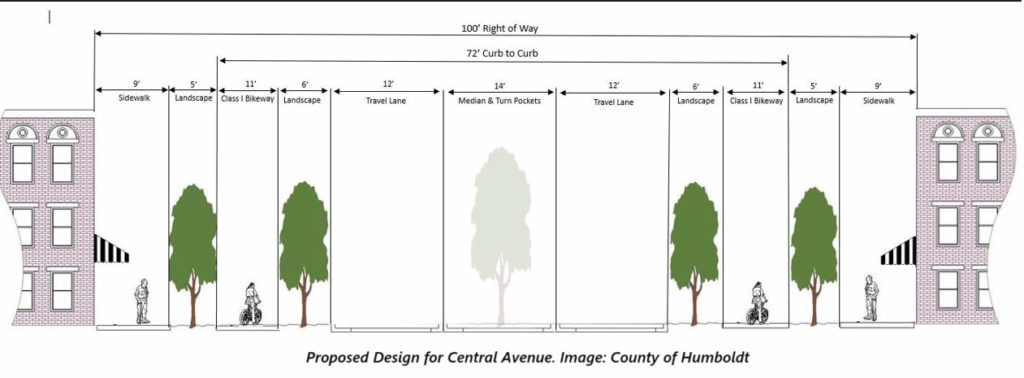
We do have a few concerns about the Environmental Impact Report, which you can read about here. Most critically, we are worried that the county is planning to implement major intersection expansion projects in response to imagined future congestion. These projects would undermine the Town Center goal of a walkable and bikeable neighborhood and encourage even more driving, and their environmental impacts are not considered in the EIR. We are strongly urging the county to disavow the intersection expansion projects and stick with the bike and pedestrian safety improvements that are part of the Town Center plan itself.
We are also disappointed that some community members continue to oppose key elements of the Town Center plan, including denser development and a safer design for Central Avenue. We encourage CRTP members and supporters who live, work or play in McKinleyville to support the proposed Town Center zoning rules and street improvements, and to submit comments urging the county not to undermine this hard-won progress by expanding local intersections and encouraging more car and truck traffic.
News from Beyond the North Coast
Immigration Crackdown Threatens Freedom to Move
The federal government’s harsh immigration enforcement techniques are making many people terrified of being picked up by federal agents anywhere they go. As America Walks points out, living in a walkable neighborhood doesn’t mean much if you’re too scared to leave home. Speak up for the freedom to move safely regardless of immigration status.
Round 2 of State E-Bike Vouchers Rescheduled
Technical difficulties led to state officials scrapping their last attempt to distribute the second round of the wildly popular e-bike vouchers. They have rescheduled the voucher release for May 29th and promise things will go more smoothly this time.
More States Approve Speed Limiters for Reckless Drivers
State legislatures in Georgia and Washington state have joined Virginia in approving bills that allow judges to require speed-limiting devices in the cars of habitual reckless speeders. A similar bill has been introduced in California.
Dangerous Streets Make Parenting Harder
Kids need safer streets and other public places where they can roam free and just be kids. So do their parents.
The Collector is CRTP’s weekly transportation news roundup, published every Friday. We focus on North Coast news, but we also include relevant state, national and international transportation news – plus other items that we just find kind of interesting! To submit items for consideration, email colin@transportationpriorities.org.
May Is Bike Month!
The Collector
May 2, 2025
May Is Bike Month!
May is Bike Month in Humboldt County, so prepare for lots of bike-related fun courtesy of the Bike Month Humboldt Coalition (of which CRTP is a member).
Events during Bike Month include Eureka and Manila Mural Rides, two pancake breakfast rides, Bike to Work and School days, and of course CRTP’s Eureka Bike Safety Audit.
A full schedule of Bike Month events can be found here.
Bike Month also comes with the Bike Month Challenge. New and experienced bicyclists of all ages and abilities are encouraged to sign up to track their rides, with the goal of biking at least five miles during the month of May. You can use a regular bike, an e-bike, a trike, an adaptive bike, or any other pedal-powered device that meets your needs!
Finally, don’t forget to visit some of our local bike-friendly businesses to get special deals when you ride your bike to shop or dine during Bike Month.
Take the Survey on Arcata Safety Improvements
The city of Arcata is considering plans to improve bicycle and pedestrian safety and access across US-101 on Samoa Boulevard, as well as adjacent upgrades to Samoa Boulevard and South G Street. Initial concepts supported by CRTP include removing several highway ramps and providing separated bike and pedestrian facilities on the overpass, as well as adding separated bike lanes on Samoa Boulevard and traffic calming measures on South G Street. If you walk, bike or roll on any of these streets – or would if they were safe! – click here to provide your input to the city.
Eureka City Council to Vote on Waterfront Plan
Several years ago, the city of Eureka adopted new zoning rules encouraging more housing production and higher density development consistent with existing Downtown and Old Town patterns, building on the strengths of the region’s most walkable neighborhoods. But a lot of this area near the waterfront is in the coastal zone and therefore requires different land use regulations addressing the mandates of the state’s Coastal Act.
The Waterfront Eureka Plan, which the city began developing in 2023, is the city’s new plan for its core coastal area. It provides a high-level vision, along with some general development parameters. (Specific zoning rules are expected later.) Next Tuesday at 6 pm, the City Council will vote on whether to adopt the plan. CRTP generally supports the plan, which will build on the dense, mixed-use character of these neighborhoods and encourage more walkable, bikeable development – but of course there’s always room for improvement!
More About That Measure O Transit Funding
As we reported last week, the Humboldt County Board of Supervisors voted to allocate 15% of Measure O sales tax revenues to public transit and 85% to roads for the next five years. That’s a meaningful amount, and will greatly benefit local transit, but of course we think it should have been more. And as the Lost Coast Outpost reports, it very well might have been more if the Board’s agenda for the day had accurately described the required vote. A majority of supervisors supported a higher amount for transit, but the supervisors in the minority used that inaccurate staff report to effectively reduce the final percentage. We find that very troubling.
News from Beyond the North Coast
Red States Are Banning Safe Street Designs
The culture war over transportation is heating up. Idaho recently passed a state law to prevent local governments from implementing widely used, evidence-based safe street designs like lane reductions (a.k.a. “road diets”) and the conversion of car lanes into bike lanes, and Texas is now debating a similar law. The Trump administration has expressed support for policies like this – Transportation Secretary Sean Duffy, for example, has complained about bike lanes taking street space from cars – and many advocates fear that this anti-safety trend will spread.
The Collector is CRTP’s weekly transportation news roundup, published every Friday. We focus on North Coast news, but we also include relevant state, national and international transportation news – plus other items that we just find kind of interesting! To submit items for consideration, email colin@transportationpriorities.org.
Measure O Transit Funding Secured
The Collector
April 25, 2025
Measure O Transit Funding Secured
On Tuesday, the Humboldt County Board of Supervisors voted unanimously to allocate 15% of Measure O revenue to transit and 85% to roads. They also removed some of the more onerous restrictions on transit that had been proposed. For example, after the county road fund balance is paid off, the supervisors specified that any excess revenues above projections will be split between transit and roads, instead of all going to roads as had been proposed. And they allowed the Humboldt Transit Authority to schedule their spending as needed over the next 5 years, instead of having to give money back each year if they don’t spend it on a certain schedule. Supervisor Wilson also inserted a 5% target for spending on complete streets features, which will help ensure that at least some of the Measure O “road” money is spent on things like bike lanes and sidewalks.
The supervisors did not give transit as much funding as we asked for, and we continue to believe it’s not enough. But this is still a win for local transit. All in all, the Humboldt Transit Authority will likely receive close to $4 million each year for the next 5 years from Measure O. For an agency that has been operating with an annual budget of about $10 million, that’s a lot, and we’re confident that they will be able to use that funding to implement meaningful service improvements.
The supervisors mentioned during Tuesday’s meeting how many calls and emails they’d been getting in support of transit funding, so it’s clear our message got through. In fact, we are confident that without the advocacy of CRTP and our allies, members and supporters – starting all the way back in early 2023 when Measure O was just a twinkle in the supervisors’ eyes, and continuing through this Tuesday – there would have been no funding for transit at all. CRTP extends our deepest appreciation to everyone who helped make this happen.
Save the Date: Eureka Bike Safety Audit
On Wednesday, May 14, 2025, from 5:30-6:30 pm, CRTP will be conducting a bike safety audit of Eureka’s 4th and 5th Streets. We’ll meet at the corner of 4th and C Streets in Eureka, and no bike is required to participate.
Bike audits are an opportunity to experience and take note of the conditions for bicyclists in a particular neighborhood or location. Unfortunately, due to the dangerous conditions on 4th and 5th Streets, we will not be riding bikes during the audit. But while we already know 4th and 5th Streets are not safe for bicyclists, the bike audit will help document the exact hazards, and suggest solutions to improve safety.
During the audit, we will walk or roll on the sidewalk while observing conditions for bicyclists, and will focus on observations of three intersections: 4th & C Streets, 4th & H Streets, and 5th & I Streets.
And don’t forget, May is Bike Month! The bike audit is just one of many local bike-related events and activities scheduled for Bike Month. Click here for more information about other bike-related events and activities scheduled for May.
Hiller Road Quick-Build Safety Project Moves Forward
This week the McKinleyville Municipal Advisory Committee gave some direction to Humboldt County Public Works staff about what they’d like to see in a new quick-build safety project on Hiller Road between Central Avenue and McKinleyville Avenue. The committee voted for buffered bike lanes along the entire stretch, narrowed traffic lanes and other traffic calming features, and a new design prioritizing safety for people (especially kids) walking and biking at the intersection of Hiller and McKinleyville.
A quick-build project uses paint and other low-cost materials to rapidly transform existing paved surfaces. These projects are generally intended to stay in place until more permanent improvements can be made – often several years – but can be easily modified based on public feedback and experience. County staff have said they plan to build the Hiller Road project this summer, which will make it the first quick-build project in the region.
CRTP is represented on the committee’s active transportation subcommittee. We suggested a quick-build at this location, and we’ve been advocating to ensure that the project prioritizes evidence-based bike and pedestrian safety measures. We’re pleased with the direction the project is going and excited to see it implemented.
Fortuna Council Approves Roundabout & Bike/Pedestrian Bridge
Last week, the Fortuna City Council approved designs for a major project including a complex, five-leg roundabout at 12th Street and Newburg Road and an adjoining bike and pedestrian bridge over US 101. The future Great Redwood Trail will also pass directly through this area, which will mean many more people walking and biking. At CRTP, we appreciate the important new bike and pedestrian infrastructure in this project, but we have concerns about the roundabout. It can be challenging to design a roundabout – especially one as big as this – in a way that is actually safe and comfortable for people walking and biking, especially kids, seniors and people with disabilities, and we’re not convinced the city has achieved that.
News from Beyond the North Coast
US DOT Threatens to Pull Huge Amounts of Federal Funding
A new memo from US Transportation Secretary Sean Duffy threatens to withhold all federal transportation funding for projects deemed to be promoting “DEI.” By the Trump administration’s vague, broad definition, that would seem to include almost all federal funding given out in recent years, since the Biden administration used equity-related metrics to prioritize funding based on legal mandates.
The new memo also threatens to immediately cut all funding to sanctuary cities and states. That designation applies to California, Humboldt County, Eureka, Arcata, and many other jurisdictions in the region. If Duffy follows through on this threat, a huge number of transportation projects locally and throughout the state will be defunded. It’s not clear if the threat also includes federal transit funding.
The Collector is CRTP’s weekly transportation news roundup, published every Friday. We focus on North Coast news, but we also include relevant state, national and international transportation news – plus other items that we just find kind of interesting! To submit items for consideration, email colin@transportationpriorities.org.

